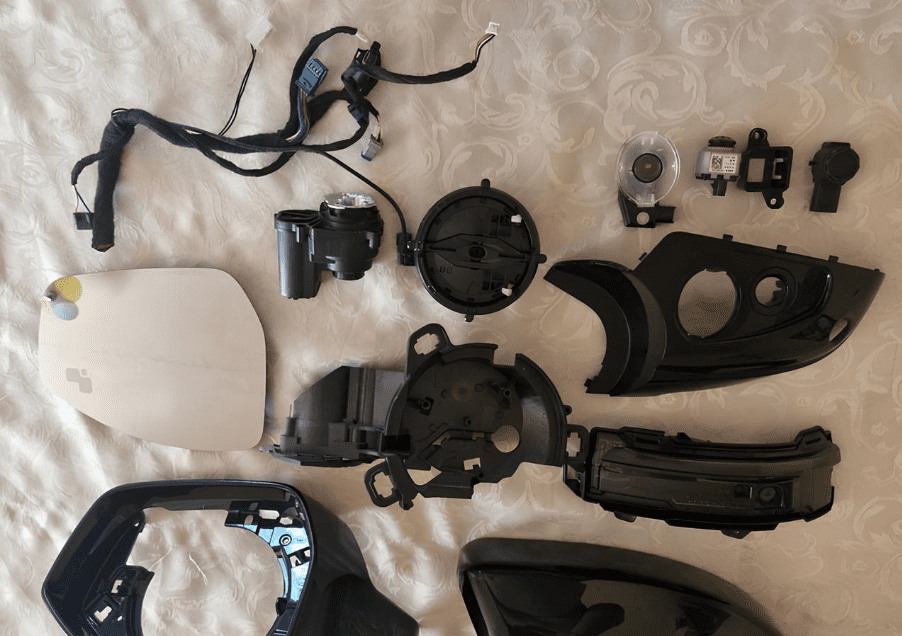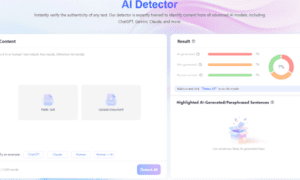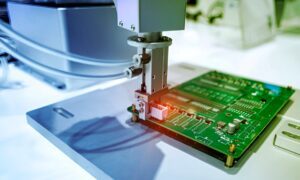Have you ever glanced at your side view mirror and seen it as just a simple piece of glass? In today’s automotive world, that perception is far from reality.
A modern side mirror is a complex, sophisticated assembly of technology designed to enhance safety, convenience, and functionality. From integrated turn signals and heating elements to advanced camera systems and blind-spot sensors, the simple mirror has evolved into a critical component of your vehicle’s nervous system.
Understanding this complexity is crucial for any car owner. Why? Because when damage occurs—a common fate for a part that sticks out from the vehicle’s body—knowing that you can replace individual car mirror parts is a game-changer. Sourcing these specific parts can save you hundreds, if not thousands, of dollars compared to purchasing an entire new assembly.
This guide will provide a complete breakdown of every component inside your side mirror. You will learn to identify each part, understand its function, make informed choices when buying replacements, and even get practical tips for maintenance and installation, empowering you to handle mirror repairs with confidence.
- A) The Core Anatomy: Understanding Essential Car Mirror Parts
- B) How to Choose the Right Replacement Car Mirror Parts
- C) Practical Advice for Your Car Mirror Parts: Installation and Maintenance
- D) Upgrading and Expanding Your Car Mirror Parts
- Frequently Asked Questions (FAQ)
o ❓ Question 1: Can I replace just the mirror glass if it’s cracked?
o ❓ Question 2: What is the main difference between OEM and aftermarket car mirror parts?
o ❓ Question 3: How do I know if my car has heated mirrors?
o ❓ Question 4: Is it difficult to replace a side mirror cover myself?
o ❓ Question 5: What is that light on the bottom of my mirror housing?
o ❓ Question 6: My mirror won’t adjust electronically. Do I need a whole new mirror?
o ❓ Question 7: Can I add a mirror with a camera if my car didn’t have one?
o ❓ Question 8: Where can I find the correct parts for my specific vehicle?
- Conclusion
H2: A) The Core Anatomy: Understanding Essential Car Mirror Parts
To truly appreciate the engineering packed into such a small space, we must first dissect the core components. These parts form the foundation of every side mirror, from the most basic manual models to the most advanced electronic units. Grasping the function of these foundational car mirror parts is the first step toward mastering their repair and maintenance.
- The Foundational Mechanical Car Mirror Parts
Before we dive into the electronics, let’s look at the skeleton and skin of the assembly. These mechanical parts provide the structure and the first line of defense against the elements and physical impacts. They are the most commonly damaged components in minor collisions or scrapes.
- The Mirror Housing: This is the main body or framework of the entire mirror assembly. Typically made from durable, black or textured ABS plastic, the housing is the component that bolts directly to the vehicle’s door. It’s the chassis that holds all other car mirror parts in place, from the actuator motor to the wiring harness. Its design is crucial for aerodynamics and reducing wind noise at high speeds. When the housing is damaged, it often compromises the integrity of the entire unit, making its replacement a priority.
- The Mirror Cover (or Cap): The mirror cover is the painted, shell-like piece on the back of the housing. Its primary role is aesthetic—it’s painted to match the vehicle’s body color, providing a seamless, finished look. However, it also serves as a protective shield for the internal components. Made from a slightly more flexible plastic than the housing, it’s designed to absorb minor impacts. This is, by far, one of the most frequently replaced car mirror parts, as it’s the first point of contact in a sideswipe. The good news is that in most cases, you can replace just the cover without needing a whole new mirror.
- The Mirror Glass and Backing Plate: The mirror glass is the component we interact with most. Modern mirror glass is more than just a reflector. It’s often convex on the passenger side to provide a wider field of view, reducing blind spots. The glass is attached to a plastic backing plate, which has clips or mounting points that snap onto the actuator motor. This connection is what allows the motor to precisely adjust the glass’s angle.
- The Key Electrical and Active Car Mirror Parts
Here’s where modern mirrors begin to show their complexity. The integration of electrical components transformed the mirror from a passive reflector into an active safety and convenience device. These active car mirror parts are responsible for the features many of us now take for granted.
- The Actuator Motor: Tucked away inside the housing, the actuator motor is a small but vital component among modern car mirror parts. It contains tiny electric motors and gears that receive input from the adjustment switch inside your car. When you press the switch, the actuator precisely moves the mirror glass up, down, left, or right. If your mirror glass won’t adjust but you can hear the motor trying to work, the internal gears may be stripped. If there’s no sound at all, the motor itself may have failed.
- The Heating Element: In colder climates, a heated mirror is an indispensable safety feature. The heating element is a thin, grid-like film attached to the back of the mirror glass. When activated (usually along with the rear window defroster), a low electrical current flows through the grid, gently warming the glass to melt ice, frost, and evaporate fog. This ensures you have a clear view, no matter the weather.
- The Turn Signal Indicator: Many modern vehicles feature an LED turn signal indicator built directly into the mirror assembly, either on the edge of the housing or behind the glass itself. This provides a clear, eye-level signal to drivers in adjacent lanes, significantly improving safety during lane changes.
- Advanced Driver-Assistance (ADAS) Car Mirror Parts
The latest evolution of the side mirror integrates it directly into the vehicle’s Advanced Driver-Assistance Systems (ADAS). These high-tech car mirror parts use sensors and cameras to provide the driver with real-time information about their surroundings, actively helping to prevent accidents.
- The Blind Spot Sensor: This system uses radar or ultrasonic sensors, sometimes located within the mirror housing, to monitor the blind spots on either side of the vehicle. When another car enters your blind spot, a warning icon (often an image of a car) illuminates on the surface of the mirror glass, alerting you to the potential danger.
- The Side View Camera (360-Degree View System): A small camera located at the bottom of the mirror housing is a key component of the advanced car mirror parts found in 360-degree or “bird’s-eye view” parking systems. It captures a view of the ground and the side of the car, and its feed is stitched together with images from other cameras (front and rear) to create a seamless, top-down view on your infotainment screen, making parking in tight spaces effortless.
- The Puddle Light: A simple but incredibly useful feature, the puddle light is a small lamp on the underside of the mirror housing. It automatically illuminates the ground next to the car when you unlock the doors, helping you avoid stepping in puddles or obstacles in the dark.
H2: B) How to Choose the Right Replacement Car Mirror Parts
When a component of your side mirror fails or gets damaged, you need to find the right replacement. When you need to find replacement car mirror parts, you’re faced with a choice. Do you go to a dealership and pay a premium for a full assembly replacement, or do you source the specific part you need and save a significant amount of money? Choosing the latter is almost always the smarter financial decision, but it requires some knowledge to ensure you get the right part for your vehicle.
Criteria for Selecting Car Mirror Parts
- OEM vs. Aftermarket: This is the first major decision.
o OEM (Original Equipment Manufacturer): These are the exact same parts that your car was built with at the factory. They guarantee a perfect fit, finish, and function. The downside is that they are typically the most expensive option and are often only sold through dealerships.
o Aftermarket: These parts are produced by third-party companies, not the car manufacturer. They are designed to fit and function just like OEM parts but are available at a much lower price point. High-quality aftermarket car mirror parts can offer a value proposition that is hard to beat, providing OEM-level quality without the OEM price tag. Reputable suppliers, like carmirrorparts.com, specialize in sourcing top-tier aftermarket parts that meet or exceed original specifications.
- Verify Compatibility by Vehicle and Features: Cars can have dozens of different mirror configurations for the same model year. A base model might have manual, non-heated mirrors, while a top-tier trim level has power-folding, heated, auto-dimming mirrors with cameras and blind-spot monitors. It is absolutely essential to verify that the car mirror parts you are buying match the exact features of your vehicle. Always use your car’s Year, Make, and Model when https://carmirrorparts.com/ searching on a specialized platform.
What to Pay Attention To
- Part Numbers: If possible, try to find the OEM part number of your original component. This is the most reliable way to ensure a perfect match, even when you buy aftermarket car mirror parts. The number may be stamped on the back of the housing or the old part itself.
- Connector Type: The wiring harness connector is critical. A mirror with a camera and blind-spot monitor will have a connector with many more pins than a simple power-adjustable mirror. Check the number of pins and the shape of the connector in the product photos to ensure it matches your vehicle’s wiring.
- Left vs. Right: This may sound obvious, but it’s a very common mistake. Remember that the “Left” side is the Driver’s Side (in LHD countries like the US and most of Europe), and the “Right” side is the Passenger’s Side.
Avoiding Common Mistakes
- Don’t Buy Based on Appearance Alone: Two mirrors might look identical from the outside, but one could be for a car with a heating function and the other not. Always read the feature list for any car mirror parts you consider.
- Don’t Assume All Parts are Interchangeable: Never assume a mirror cap from a 2018 model will fit a 2019 model, even if the car looks the same. Manufacturers often make small, unnoticeable changes between model years.
- Forgetting the Small Things: When replacing a component, check if you need any extra clips, screws, or adhesive. Sometimes these are not included with the replacement part.
H2: C) Practical Advice for Your Car Mirror Parts: Installation and Maintenance
Once you’ve selected and received the correct replacement part, the next step is installation. While taking your car to a mechanic is always an option, many car mirror parts are surprisingly easy to replace yourself with basic tools and a little patience. Proper maintenance can also extend the life of your mirrors and keep them looking great.
Applying Your Knowledge: Basic Installation Guides
While every car is different, the general principles for replacing the most common components are quite similar.
- Replacing a Mirror Cover (Cap): This is often the easiest repair.
- Angle the Glass: Use your power adjustment to tilt the mirror glass all the way inwards or upwards to create a gap.
- Release the Clips: Using a plastic trim removal tool (to avoid scratching the paint), gently pry between the cover and the housing to release the internal retaining clips. There are usually 3-5 clips holding it in place. Work your way around slowly.
- Snap on the New Cover: Align the clips on the new cover with the slots on the housing and press firmly until it clicks securely into place.
- Replacing the Mirror Glass:
- Protect the Paint: Place a soft towel or painter’s tape on the painted surface below the mirror to prevent scratches.
- Remove the Old Glass: Tilt the glass to create a gap. Using a trim tool or a flat-head screwdriver wrapped in tape, gently pry the glass and its backing plate off the motor mount. If it’s a heated mirror, carefully disconnect the two small electrical spade connectors.
- Connect and Install: Connect the heating wires to the new glass (if applicable). Align the new backing plate with the motor mount and press firmly in the center until it snaps into place.
Caring For Your Car Mirrors
- Cleaning: Use a dedicated automotive glass cleaner and a clean microfiber towel. Avoid using abrasive paper towels, which can cause fine scratches over time. For the plastic housing and cover, use a standard car wash soap.
- Protection: Applying a coat of car wax or a ceramic sealant to the painted mirror cover will protect it from UV rays, bird droppings, and water spots, just like the rest of your car’s paint. Proper maintenance can also extend the life of all your exterior car mirror parts.
- Winter Care: Avoid using hard plastic ice scrapers on your mirror glass. Rely on the heating function to melt the ice. If you must scrape, use a soft-edged tool or the soft side of your scraper.
Lifehacks and Additional Recommendations
- Stuck Mirror Glass? If the old mirror glass is difficult to pry off, you can use a hairdryer or a heat gun on a low setting to gently warm up the plastic backing plate, making it slightly more flexible and easier to release from the motor mount.
- Painting a New Cover: If you buy an unpainted, “paint-to-match” mirror cover, you don’t always need a professional body shop. You can buy automotive spray paint that is color-matched to your vehicle’s factory paint code. With proper preparation (cleaning, priming) and technique (multiple light coats), you can achieve a near-perfect finish yourself.
- D) Upgrading and Expanding Your Car Mirror Parts
Thinking beyond simple repairs, understanding the modular nature of car mirror parts opens up possibilities for upgrades and enhancements. It also allows you to better appreciate the integrated safety systems you might already have.
Expanding Your Horizons: Upgrading Your Mirrors
One of the most common questions is: “Can I upgrade my mirrors to a higher trim level?” The answer is a qualified “yes.” It’s often possible, but it requires research.
- Adding Heated Mirrors: If your car didn’t come with heated mirrors, you can sometimes add them. You would need to purchase heated mirror glass and potentially a new wiring harness and a switch for your dashboard. In some vehicles, the wiring might already be in the door, making it a much simpler “plug-and-play” installation.
- Adding Turn Signals: Upgrading to mirrors with integrated turn signals is a popular safety enhancement. This almost always requires running new wires from the vehicle’s main turn signal circuit through the door and into the mirror housing. While more involved, it’s a very rewarding DIY project for the experienced enthusiast.
- Challenges: The biggest challenge in upgrading is the vehicle’s electronics. Some features, like power-folding or blind-spot monitoring, are controlled by the car’s Body Control Module (BCM). Simply installing the hardware might not be enough; the feature may need to be “activated” in the car’s computer system using specialized diagnostic tools.
A Success Story: The Power of Individual Part Replacement
Consider the story of Sarah, a daily commuter. One morning, she returned to her parked car to find the cover of her passenger-side mirror cracked and hanging off after being hit by another car in the parking lot. The glass and motor were fine, but the painted cover was ruined. Her initial quote from a dealership was over $400 for a complete new mirror assembly, plus labor.
Feeling discouraged, Sarah did some online research. She https://carmirrorparts.com/“>found a pre-painted, color-matched cover for her exact model online for under $50.
Following a 5-minute video tutorial, she easily snapped off the old cover and clicked the new one into place. The repair was perfect, and she saved over $350 and a trip to the dealership. This common scenario highlights the immense value of understanding that you don’t always need to replace the entire assembly of car mirror parts.
H2: Frequently Asked Questions (FAQ)
H3:❓ Question 1: Can I replace just the mirror glass if it’s cracked?
✅ Answer: Absolutely. In fact, you can https://carmirrorparts.com/ browse a wide selection of replacement mirror glass which is sold separately, making it a very cost-effective repair.
H3:❓ Question 2: What is the main difference between OEM and aftermarket car mirror parts?
✅ Answer: OEM (Original Equipment Manufacturer) parts are made by the car manufacturer and are identical to the ones your car came with. Aftermarket car mirror parts are made by other companies. High-quality aftermarket parts are designed to be a direct replacement and can be just as good as OEM, but at a much lower cost.
H3:❓ Question 3: How do I know if my car has heated mirrors?
✅ Answer: Look closely at the mirror glass. Most heated mirrors have a small universal symbol of a rectangle with three wavy arrows pointing up. Alternatively, check your dashboard or climate control panel for a button with this same symbol, which often activates along with the rear defroster.
H3:❓ Question 4: Is it difficult to replace a side mirror cover myself?
✅ Answer: No, this is typically one of the easiest DIY car repairs. Most mirror covers are held on by a few internal clips and can be carefully pried off and replaced in just a few minutes with a simple plastic trim tool.
H3:❓ Question 5: What is that light on the bottom of my mirror housing?
✅ Answer: That is called a “puddle light.” Its purpose is to illuminate the ground next to your car when you unlock it or open the door, which is a helpful convenience and safety feature in the dark.
H3:❓ Question 6: My mirror won’t adjust electronically. Do I need a whole new mirror?
✅ Answer: Not necessarily. The problem is likely the internal actuator motor. This motor is often available as a separate replacement part, and you can https://carmirrorparts.com/ find a compatible actuator motor for your vehicle right here. If you can fix it by replacing just the motor, you can save a lot of money compared to buying the entire assembly.
H3:❓ Question 7: Can I add a mirror with a camera if my car didn’t have one?
✅ Answer: This type of upgrade is extremely complex. It’s not just a hardware change; it requires the correct wiring, a compatible infotainment system, and programming the car’s computer to recognize the new hardware. It is not recommended as a simple DIY project.
H3:❓ Question 8: Where can I find the correct parts for my specific vehicle?
✅ Answer: The best way is to use a specialized online retailer that allows you to filter by your vehicle’s year, make, and model. This ensures compatibility and helps you find all the available car mirror parts for your specific model, from a simple cover to a complex assembly.
H2:Conclusion
As we’ve seen, the modern side view mirror is a marvel of engineering, packed with distinct car mirror parts that each serve a vital function. From the protective outer shell to the complex network of motors, heaters, and sensors within, understanding these components is the key to making smart, economical repair decisions. You no longer need to accept a costly full assembly replacement for a single broken part. Armed with this knowledge, you can confidently diagnose issues, source the exact car mirror parts you need, and even perform the repair yourself. Take control of your car’s maintenance and keep it looking and functioning its best.
Ready to find the exact part for your vehicle? Explore a comprehensive selection of high-quality mirror parts now.
- Focus Keyword – Car Mirror Parts
- Seo title – Car Mirror Parts: Save 50% With This Smart Guide
- Meta Description – Don’t overpay for repairs! Our ultimate guide to car mirror parts shows you how to replace everything from the cover to the camera sensor and save money.
- Permalink – /car-mirror-parts
- The link to our website must be a “do-follow” link: https://carmirrorparts.com/
- Main pictures alt text: – An overhead view of disassembled Car Mirror Parts laid out on a white textured surface, showing the individual components like the housing, glass, wiring harness, and internal mechanisms.
- Pictures 2 alt text – A close-up of a modern car’s side mirror with a bright LED turn signal, illustrating high-quality Car Mirror Parts.
- Pictures 3 alt text – A car’s side mirror with an illuminated yellow blind-spot monitoring system icon on the glass, an example of technology integrated into modern Car Mirror Parts.





























